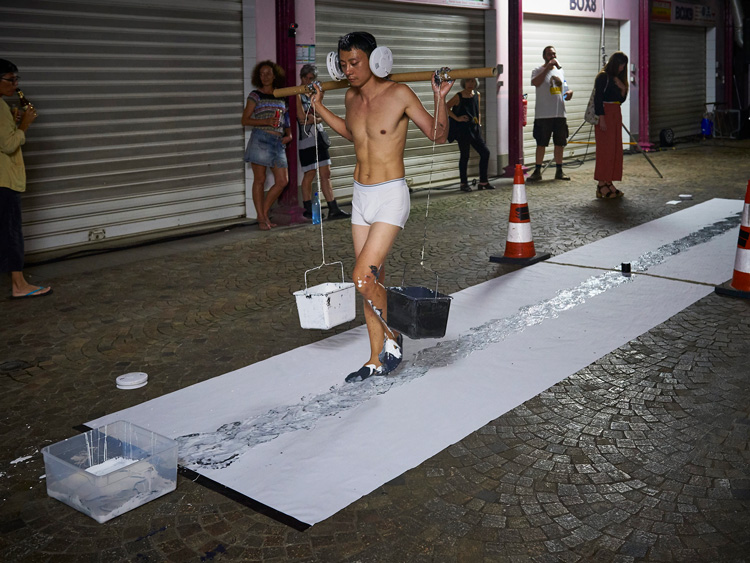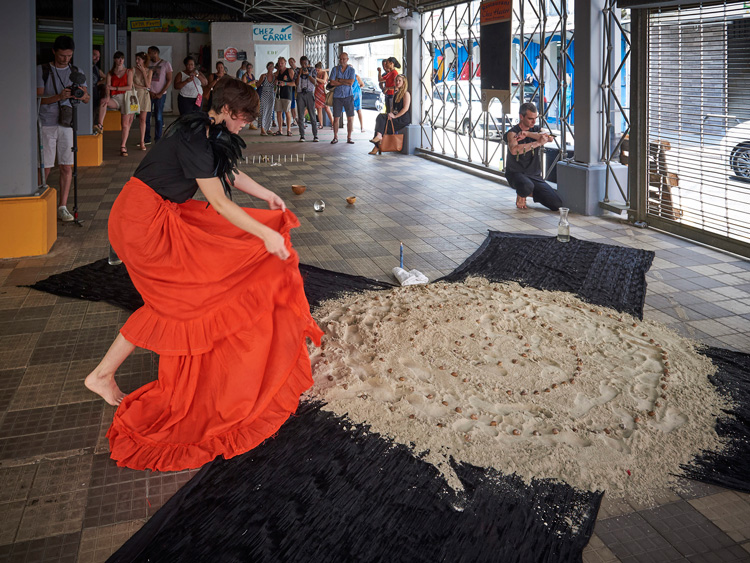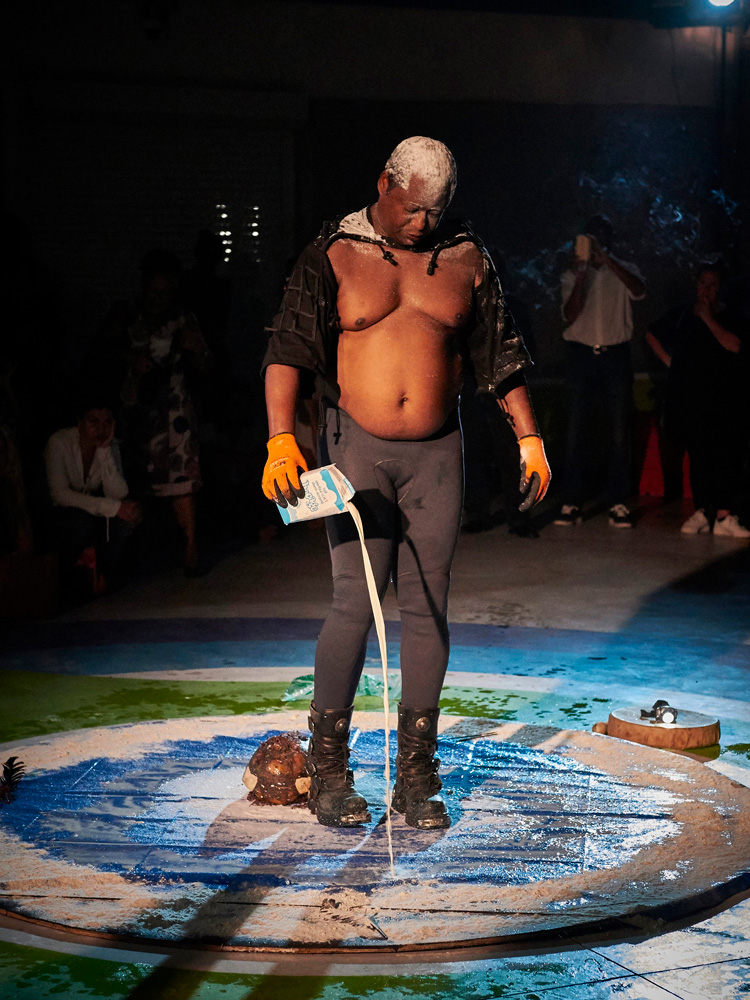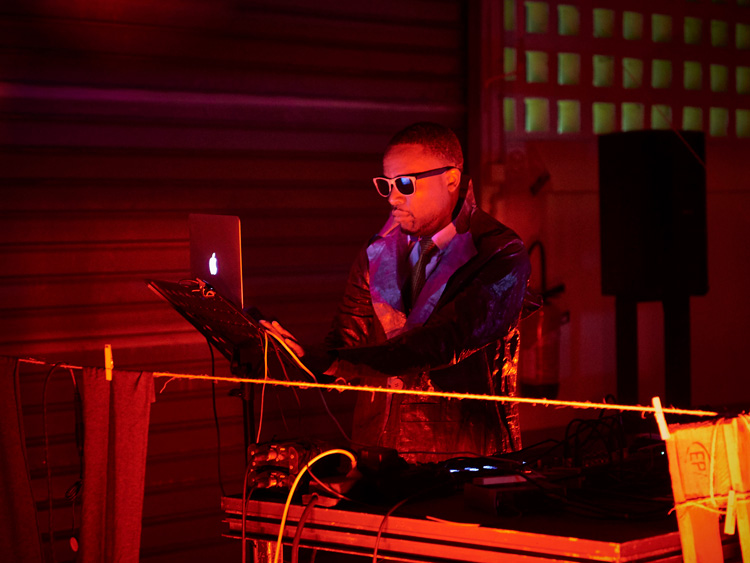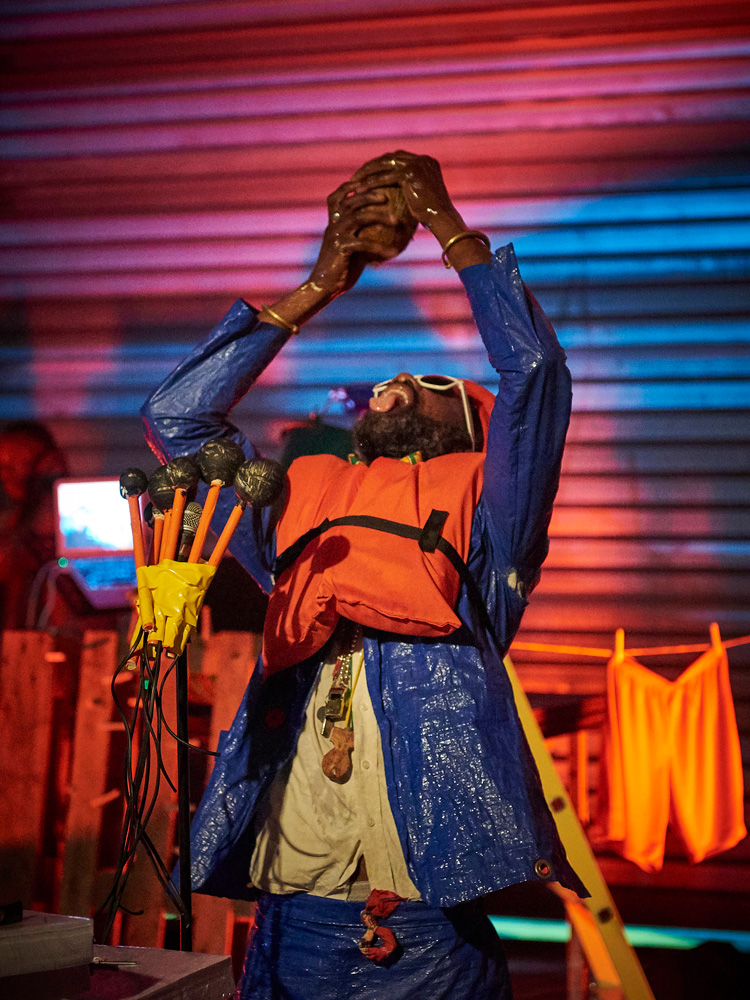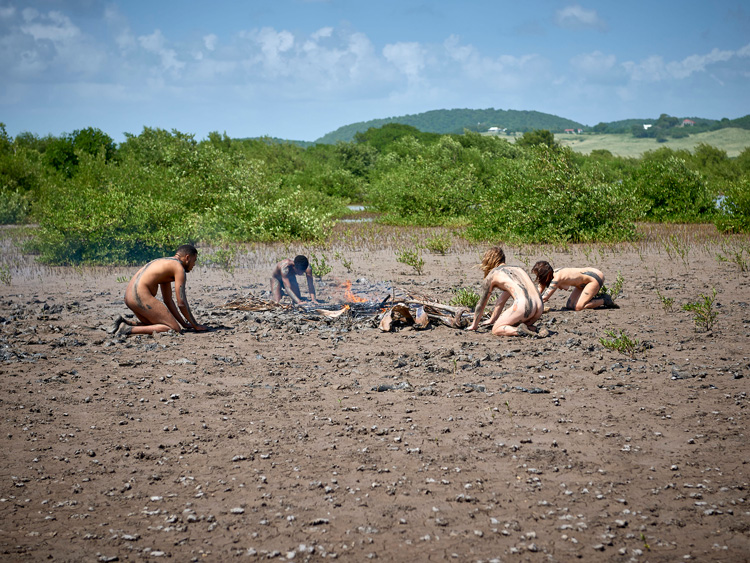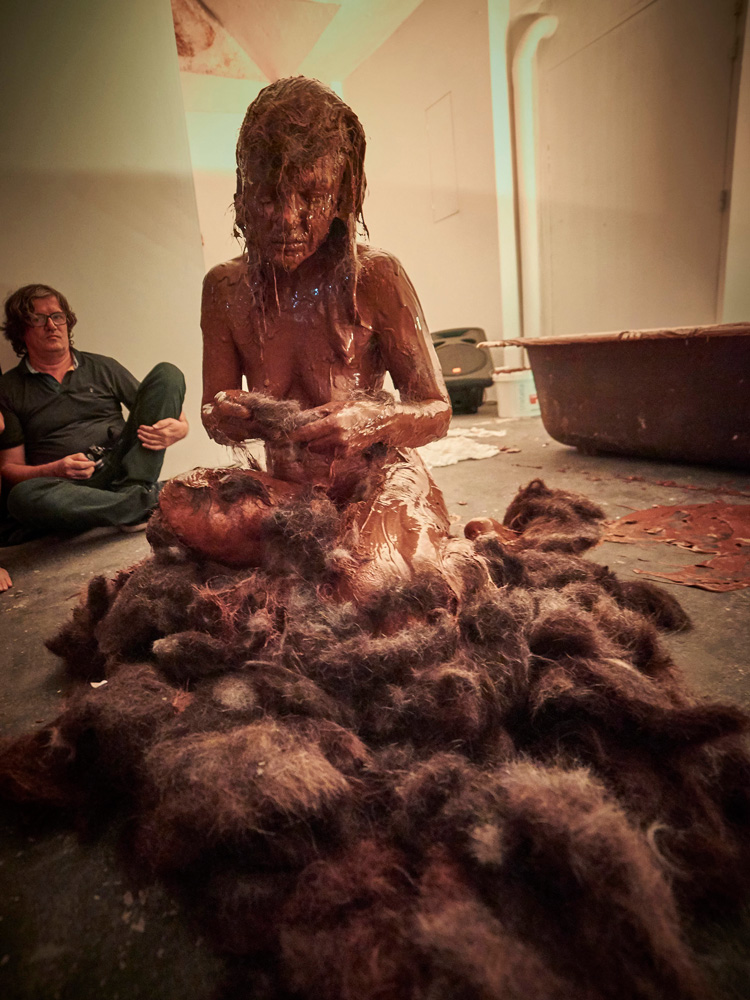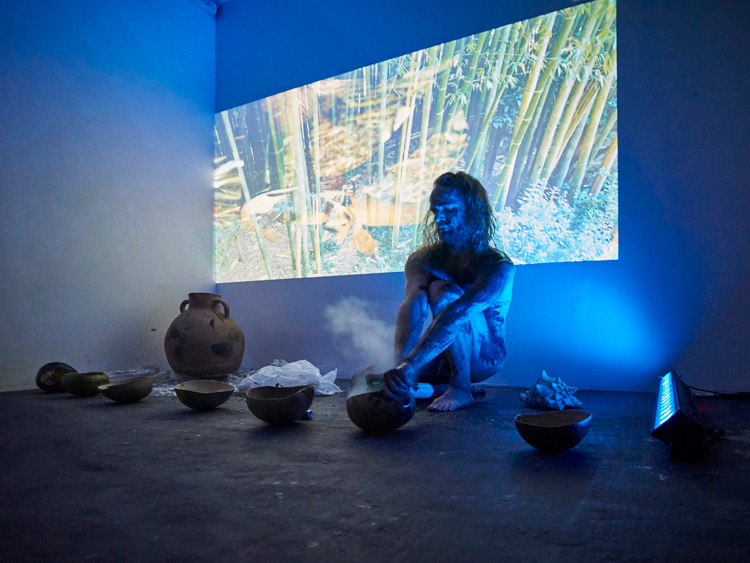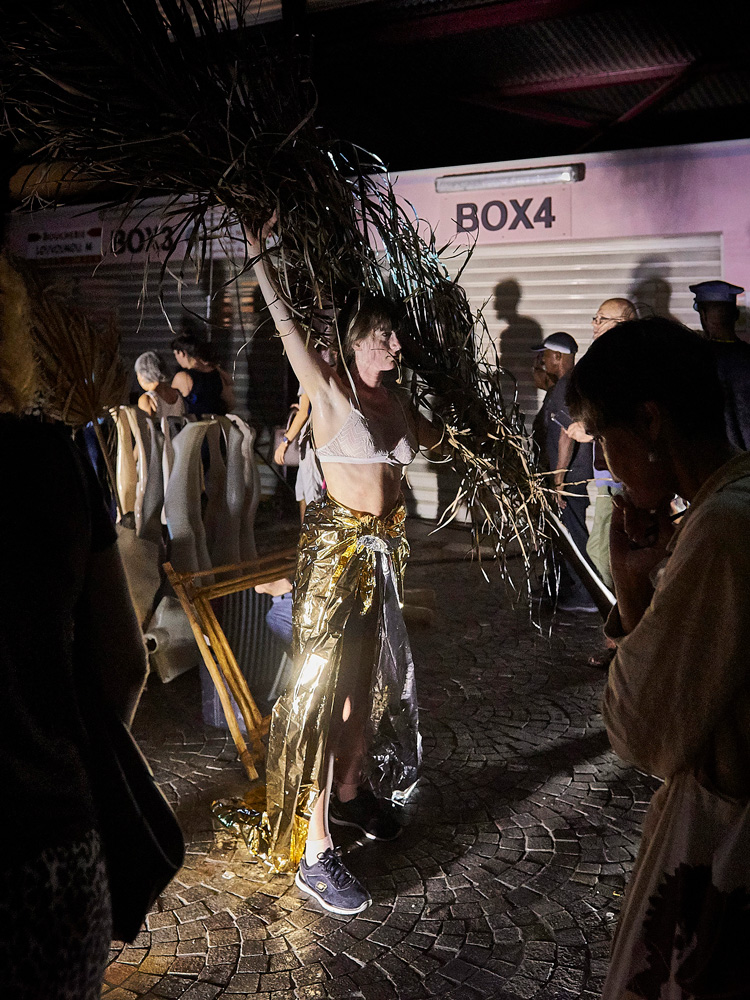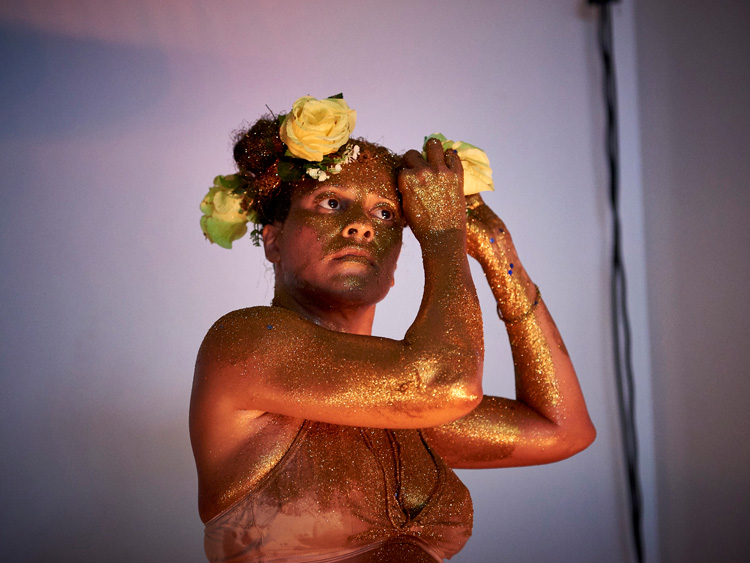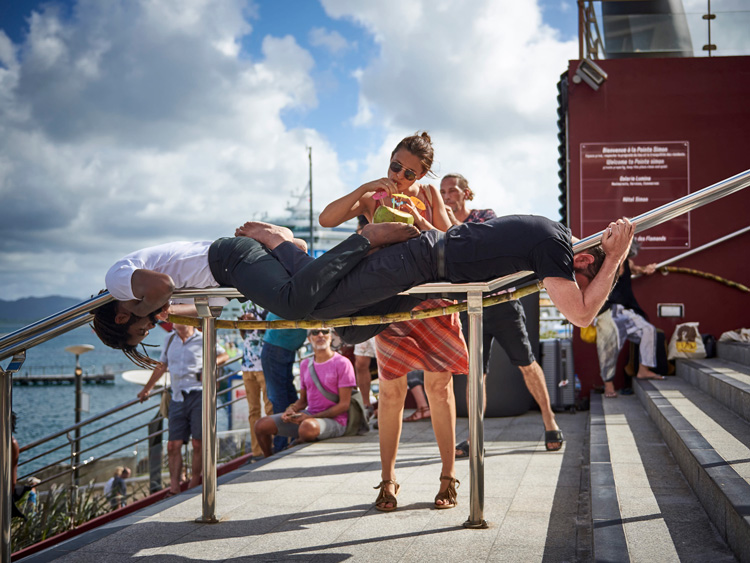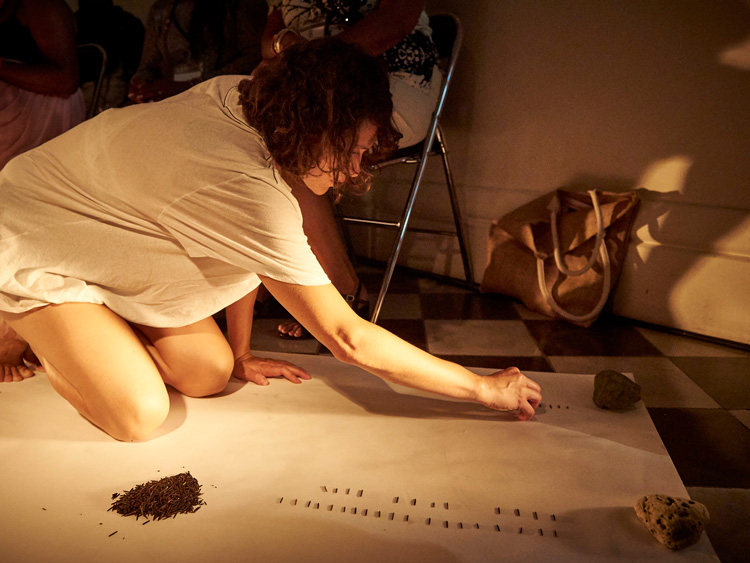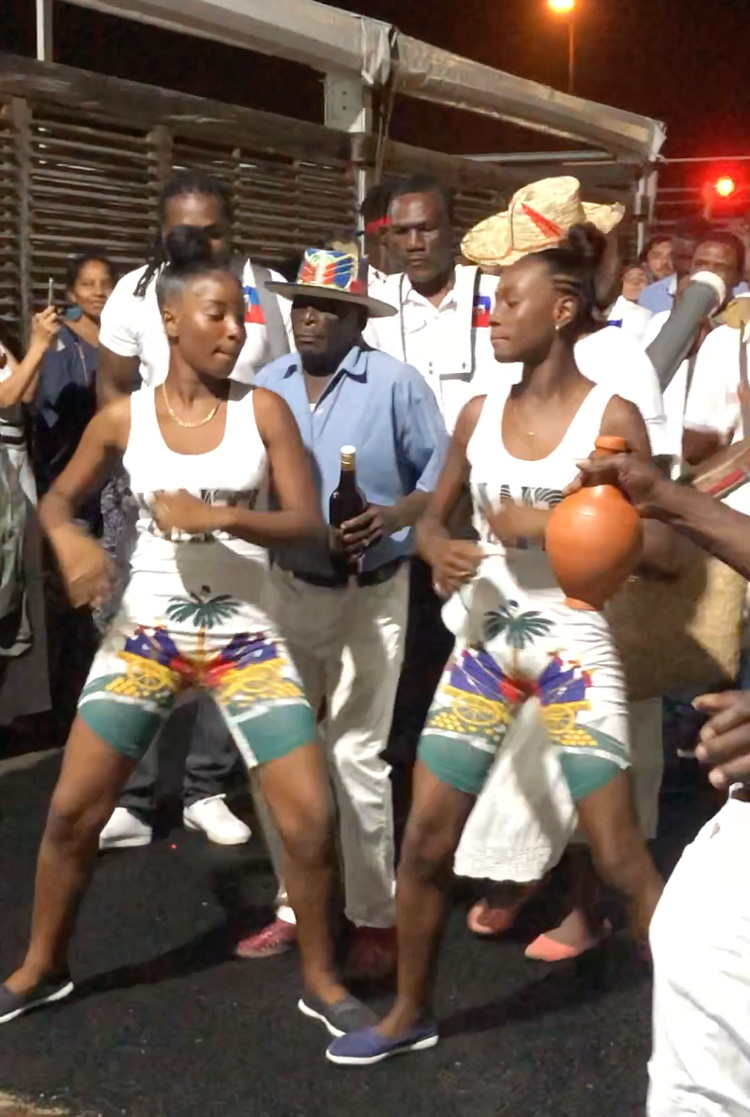

Fort-de-France, Martinique
5-12 November 2019
by LILLY WEI
The second edition of the International Festival of Performance Art (FIAP) took place in Fort-de-France, the capital of Martinique, an island in the West Indies, on 5-12 November, and was remarkable for its immediacy, emotional depth and extreme humanity – there was not much theory here. Ratcheted up several notches from the first edition (concentrated in one venue, the Hôtel L’Impératrice), it added nine more locations this time, including the uncombed, wildly beautiful forests and wave-pounded beaches of the Savane des Pétrifications in the south of the island. The number of participating artists also jumped up, the performers representing more nationalities, from the United States, Canada, France and Spain, as well as from Martinique and other Caribbean countries. The festival was once again organised by Artincidence; its founders, Annabel Guérédrat, a native of Martinique, and Henri Tauliaut, who was born in nearby Guadeloupe, were the co-curators.
The idea of creating a festival for Martinique was inspired by a visit to Grace Exhibition Space in Brooklyn in 2017, a venue “run by artists for artists”, which Guérédrat and Tauliaut greatly admired, they told me during a breakfast interview. There is no tradition of performance art on Martinique, they said, but there is a deeply rooted one of rituals, carnivals and improvised popular theatre derived from a mix of African and Indigenous cultures that webs the Caribbean. That tradition likewise features the body and is characterised by direct interactions between actors and audience, a practice that mixes art with life. Bringing contemporary performance to Martinique was an obvious way, they realised, to connect past, present and future and initiate a conversation across geographic and cultural boundaries.
[image3]
Guérédrat said that, for this edition, the performances were more elaborate, multimedia, with a greater emphasis on the installations, on costumes, sound and video, although most of the performers still foregrounded the body – often naked – and its expressiveness. Yet even if there were the budgets for costly productions, such values were not the standard here, nor were they needed. FIAP was not concerned about saleable products, a refreshing resistance to commercialisation in a moment in which the art world (and not only the art world) has been vampirised by big business and a corporate ethos for which money is the lifeblood.
The overall theme was the neo-colonial history of Martinique and the curators asked the participating artists to be aware of the complexities of that history – social, political, economic – including the accelerating urgency of environmental and social issues that are of life-and-death significance to the Martiniquais and the peoples of the Caribbean in general. For the first edition, they had not expected many attendees from the general public, but the festival was featured on Martinique television, so their audience became almost the “entire island, since everyone watches television here”, Guérédrat said. Nonetheless, they feel no need to grow the festival, just to keep it going in an unforced, organic way that remains true to their vision.
[image6]
Tauliaut emphasised that, for them, it was important to acknowledge nature and not just to make urban performances, which is why the collaborative research projects in the Savane were such an important aspect of the festival. It is necessary to be in nature, he said, with no control or expectation, and to keep it as open as possible. What is created depends on what nature offers, and whether the work succeeds or fails does not matter. This experimental component and the insistence on process was unusual for such exhibitions, at least in my experience. But its unscripted concept was freeing for the artists, many of whom had just met, as they scavenged for materials in the Savane, working with each other. It was improbably idyllic and offered chance as a recipe for creativity: take one Edenic setting, add artists and shake. There were other workshops for artists and art students scheduled throughout the week of the festival and students were invited to present their work as part of the programme. One standout was a rousing, crowd-pleasing performance by D’Jessy Pastel about transgender identity, something that is not yet widely accepted – and not always safe to reveal – in Martinique.
[image13]
The opening events began at the Quai des Tourelles, a cruise ship terminal, with a procession of Haitian musicians, Nouvel Jénérasyon Tout Moun jwenn Rara Péyi a, playing fantastical DIY instruments to an infectiously percussive beat. It was followed by a commanding performance by Tauliaut, Egwe, that took place on a sizeable blue circle that represented the Earth. It incorporated materials such as flour, milk, sugar, salt and beans, as symbolic of Afro-Caribbean culture, offering them as ritualistic gifts to attendees. He sprinkled the circle with flour, used a tortoise shell to call the spirits, then added sugar to sweeten the world and milk for prosperity. Representing a mambo (a Voodoo priestess) or a shaman, Tauliaut’s powerful presence was gentled by a graciousness that seemed to cast a halo around him.
[image4]
Next up was Nyugen Smith (raised in Trinidad, based in Jersey City, New Jersey) and Marvin Fabien (born in Dominica, based in Martinique). Focused on climate change, Lest We Forget (2017) was shown in its third version here, performed by an elaborately robed Smith and Youly Agasta. Fabien provided the audio and light components, as he did for several of the FIAP performances, sourced in Afro-Caribbean music, among other influences. Interacting with the viewers, pulling them in as participants, Smith and Agasta switched from history and allegory to oratory for its gripping conclusion, declaiming, in English and in Creole (Martinique is Francophone), the memorable speech of Dominica’s prime minister Roosevelt Skerrit, before the UN in September, 2017, pleading for aid in the wake of the devastating hurricanes that had ravaged the Caribbean: “We have made no contribution to global warming that can move the needle. But yet we are among the main victims.” Lest We Forget also points out that the issue is not simply climate change, but also the mass migrations that it precipitates, causing further devastation.
[image7]
The body, as an eloquent, sensate instrument of communication across race, culture, history, the political and social – was a mantra for this festival, and especially critical to the memorable performances of Alicja Korek (born in Poland, based in Lyon, France), Alex Côté (born and based in Montreal, Canada) and Guérédrat. Korek, a feminist, gave a riveting performance, Chrysalide(s), in La Station Culturelle, one of the sites for the festival. Both vulnerable and defiant, she was framed by a video of cockfighting, a pervasive local tradition, as she performed, her piece recalling Yoko Ono’s famous 1964 Cut Piece, in which the audience snips away at Ono’s clothing. It also suggested American artist Karen Finley’s controversial chocolate-smearing performances, and seemed to nod to Jean Cocteau’s film Beauty and the Beast (1946), a cult classic, as Korek transforms herself from beauty into a beast that might be beautiful after all, in an effort to shield herself from the rapacious male gaze of a patriarchal culture. Her variations included asking the audience not only to cut her clothing, but to contribute something of theirs; taking a bath in litres of liquid Martinican chocolate; then coating herself completely in kilos of women’s hair, including the hair of viewers who offered theirs. Cocooned, but also exposed, it was a complex, evolving gesture about transformation and the fluidity of identity. “You are the subject and object,” Korek said, “and that can be extremely powerful.”
[image8]
Water.Sync was Côté’s main performance (although he contributed several projects to FIAP that he improvised on site). It focused on the increasing scarcity of water, an irreplaceable substance, as well as on its rising levels around the world. Vast tracts of land now above sea level, even entire countries, will be destroyed, according to projections that are no longer far off in the future. He added to that a condemnation of the careless pollution of this most vital of natural resources by pesticides and other toxic chemicals, as well as using it as a dumping ground for non-biodegradable materials. Formulating the project in 2018 in Portugal, he travelled around the world for three years beforehand doing research, filming magnificent landscapes, seascapes, waterfalls, rivers, trees, all endangered and all invaluable. In this second presentation of Water.Sync, the films streamed behind him; on the ground in front of it were carefully laid-out objects of symbolic and narrative meaning that he found here. This included a large pottery vessel that seemed bottomless as he extracted water, earth, stones, shells, even dead fish from it that he shared with the spectators. Côté began by tightly encasing his naked body in plastic, another instance of cocooning, although this was not metamorphosis according to any natural cycle. Unable to breathe, he stayed in that position for enough time to cause some anxiety on his behalf before he fought his way out of his artificial sac (or shroud), desperate for air.
While the videos might have benefited from a larger venue with a surround installation, La Station Culturelle had its compensations, offering us the impact of intimacy, allowing us to share the same space, almost touching him, while the film opened up the space, breaking the fourth wall in front and back. For Martinique, he reminded us that the islands in the region will suffer more – and sooner – when the apocalypse arrives, its deadly consequences already felt by the unprecedented high seas and hurricanes of the past three years. Côté said he doesn’t have a scientific background to lend its authority to his projects; instead, his language is poetic, visual, about beauty and its loss.
[image10]
Guérédrat, who was seven months pregnant, also performed at La Station Culturelle, her project called BB Beloved Baby. Disrobing in front of the audience, she went through a series of feminine grooming and beautification routines, from twisting and taming her corona of thick black hair into a taut ball on either side of her head and thrusting flowers into them to rubbing her body with some kind of salve. Eventually, she showered gold glitter down on herself, becoming an idol, a resplendently luminous Earth mother goddess. This act of self-transformation was empowering and unapologetic, proudly affirming –and rightly so – the female body and its ability to create new life. She then left the space at a regal pace to go outside into the city streets, followed by a procession of her viewers: art as part of life, as the Russian constructivists demanded, many of whom were women.
Moïra Dalant (born in Thiers, based in Paris) was paired with Miao Jiaxin (born in Shanghai, based in Bushwick, New York) for the workshop at the Savane des Pétrifications. Delant said that, as a feminist, the female body is the starting point for all her work, but she is constantly searching for new ways to go beyond conventional representations of it. For their collaborative project at the Marché des Viandes (Meat Market), a video of the several experiments that she and Miao devised in the Savane was played overhead, incorporated into the installation. Dalant performed alone, however, a solo that was more or less impromptu, in the spirit of FIAP’s embrace of process, sparked by the discussions that she had with Miao and the materials they had collected together.
[image9]
Dalant said: “I am in a space, there are people in that space with me. What are the possible interactions, what is expected, and how do I navigate between the expected and the interrogation of those expectations?” Because they had begun the project in the sea at the Savane, she thought of the carved female figureheads affixed to ships’ bows that served as guardians from the dangers of voyages. The figureheads might also conjure the vessels of slave ships that plied the Caribbean (of not much succour to their luckless victims). As she slowly ascended and descended a ladder, wrapped in gold foil, climbing from dark to light and the reverse, she carried a palm branch like a banner or a lance, ringed by a disturbing cache of discarded mannequin parts (women’s legs and torsos that were retrieved from a nearby street). I thought of other readings. The chiaroscuro of the lighting made me think of a Rembrandt or a Caravaggio, an ascension or descent from the cross, say, with a gender switch in the latter, made three-dimensional, and startled into slow, mournful motion. But Dalant wants it understood that there is no specific narrative in her work; there is just a sequence of actions to be interpreted.
Miao’s solo, Borders, was a minimalist, lo-tech performance. Consisting of an action repeated over and over again that was never, of course, quite the same, its power was cumulative. It also took place in the Marché des Viandes and was another debut. It referred to walls of all kinds that block access, visible and invisible (for instance, you might think of those along the United States and Mexican boundary, the computer firewalls thrown up by authoritarian regimes such as China, or those between Martinique, an overseas department and its counterparts in France). “Walls are an international issue,” he said, “and we need to cross them.” The performance consisted of Miao in shorts; clapped over his ears were two expired smoke detectors worn like headphones, and slung across his shoulders was a cardboard tube from which dangled two plastic buckets filled with black and white paint, suggesting a Chinese field labourer. Miao dipped his feet into the buckets, alternating between them, and then walked carefully across two long strips of paper – and over the previous footprints he made as the performance went on. It became increasingly slick, hazardous – he nearly slipped a number of times.
[video1]
Miao Jiaxin. Borders, 10 November 2019. 120 min. Video: Lilly Wei
Laid flat on the ground like an unrolled Chinese scroll (eventually, the footprints, like brushstrokes, formed an abstract painting in grisaille, conjuring the blending of globalism, perhaps, which he destroyed afterward, regrettably), he left a narrow space between the two lengths to indicate a border. He traversed his paper route for nearly two hours, adjusting his gait almost into a goosestep at times, until the paint ran out, in time to the shattering, anxiety-producing beeps of the smoke detectors, which went off at 30-second intervals, the time he allotted to walk one strip. Pausing, he waited for the beeps to resume, then stepped over the break, and proceeded to the other end where he turned around, waiting for the beeps to start up, then began the journey back. An engrossing piece, it harboured multiple layers of references and possible readings folded within the tightness of its choreography. He said: “I see performance as a state of mind; I see art as resistance.”
[image2]
Isil Sol Vil x Marina Barsy Janer, a collaborative from Barcelona, also based their performance, Islas Cicatrices (Islands of Scars), on ritual and heritage. Tracing the path of colonisation from Spain to the Caribbean (he is from Catalonia, she is from Puerto Rico), they presented a cadenced, mesmerising allegory that slowly built up to a crescendo, a rumba triumphantly danced by Barsy Janer, dressed in a stunning red skirt. Their sense of the spiritual, they said, “is always symbolic, political, and anti-capitalistic”, seeded by alchemy, numerology, botanicals and their powers as brujas (witches) and orishas. Memories of the Inquisition and the persecution of witches and others deemed heretics, and the colonisation of the Americas linger at the edges of their narratives, which are a kind of purification rite. Elaborately installed, elegant, every object is specific and significant, offerings to link and heal, from the rosemary that Barsy Janer inserted under the skin of So Vil’s arms and other herbs they brought here from revered sites in Catalonia to the sulfur from Martinique and its soil.
[image11]
André Éric Létourneau, also from Montreal, has called himself an activist “intermedia” artist, his act of transgression to perform in public spaces without permission. Collaborating with Laurent Troudart, as part of FIAP’s program of joint ventures, he installed himself face down on the upper section of the railing of the monumental outdoor staircase leading up to a grandly scaled plaza edged by tall buildings, with Troudart at the lower end. The site was chosen for its proximity to the docks, where enormous cruise ships disgorge their passengers. The harbour signified, as did the tourists, Létourneau said, an “ungrounded” location. They made signs that promised free drinks and entertainment, hoping to attract them. The entertainment was a hybrid of Québécois and Caribbean songs that shared similar lyrics and rhythms sung by the two artists, pointing to the intertwining of cultures, while the drinks consisted of coconut water in a split coconut resting on Létourneau’s back with two straws, a bottle of rum on the side. No tourists took the bait, but others present did.
[image12]
The closing performance, another premiere, was Eating Bones and Licking Bread by Lara Kramer, a dancer, choreographer and performance artist from Montreal. Placing wild rice on an unrolled sheet of paper for nearly 45 minutes, grain by grain, as if each were a jewel and precious – which it is – she invoked the fraught, disheartening and complicated histories of her maternal ancestors, the Ojibwe and Cree. Wild rice was both a staple and a way of life, and Kramer used it to represent annihilated traditions and the realities of want, of a colonialism and racism that is not truly in the past in which the strip of paper represents the small percentage of land that is acknowledged as the property of First Nation peoples (from the vast tracts that were once their homelands). “Rice isn’t just rice, it’s many things and each grain is endowed with a spirit, a story, a potential, reflecting a state where everything is in flux and transformative,” Kramer said. Not intended as a specific narrative, Eating Bones and Licking Bread addressed trauma, linking it to Martinique, its soil poisoned by pesticides, and to any place where food is in short supply, where life is compromised and barely sustainable. But it is also a tribute to endurance, to humanity, and a fierce will to survive, despite all odds.
Fabien said that, in Dominica, it is customary to share fire by putting some embers in a coconut gourd and bringing it to your neighbours. That is what this festival felt like, a relaying and sharing of the fire between artists, organisers and the audience. It might have been a little rough around the edges, but that was part of its authenticity, its potency, its great charm. After all, think of the alternatives.
